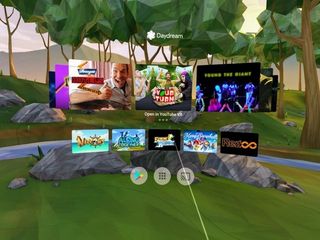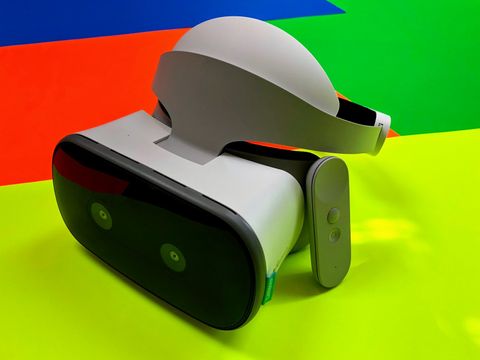AC
Score
3
Ask people who have not yet bought a VR headset why they don't have one and you usually get one of three answers. Either the headsets are too expensive when you add in the cost of the still-necessary powerful PC, the cable connecting you to a big box is awkward and not fun, or the headset requires you to use your phone and your phone is too busy being your phone to also be your VR computer. (There's a fourth set of people who say VR headsets "look funny" but I'm not talking to those people right now.)
For the willing remaining group, Daydream Standalone is made for you. A reasonably-priced headset with its own computer and no external tracking hardware to worry about. You put the headset on, the VR world appears before you to interact with, and when you take the headset off, your phone has the same amount of battery it had when you started. It's the natural evolution of Google's vision of VR for Everyone, a headset that can deliver an experience good enough to encourage you to wear it for hours at a time without any of the big drawbacks currently associated with the "desktop" VR headsets.
After HTC took its Daydream Standalone headset to China as the Vive Focus, Google partnered with Lenovo to deliver the first of these new VR experiences. It's called the Lenovo Mirage Solo, and it's launching with some seriously big expectations to meet.

Not what you're used to
Lenovo Mirage Solo Hardware
Forget everything you know about Google's Daydream headsets. The all-fabric design, removable plush faceplates, and multiple color options to choose from. This is a Lenovo-made headset, which means Lenovo's design language is on display, for better or worse. That means what you're getting is functionally much closer to Lenovo's other VR headset, the Windows Mixed Reality-based Explorer headset.
This headset is almost entirely white plastic with some silver accents and black padding. Instead of straps, there's a plastic halo with a big gear on the back to help mount it to your occipital bone. This halo design is great for people who don't like having a VR headset putting pressure on their face, but it also means if you're in a well-lit room, the light around you can leak in. Some manufacturers solve this problem with dark fabric or matte black plastic to keep the light from being distracting, but Lenovo didn't do either of these things, so the white plastic really sticks out if there's a lot of light behind you.





Looking at the Mirage Solo head-on, you're faced with a pair of big round eyes. These cameras on the front of the headset don't do any fancy Augmented Reality tricks, but instead power the WorldSense part of the headset to make the inside-out tracking work. That means the headset can figure out where it is without needing any external trackers like the Oculus Rift or HTC Vive, which is great. It also works well in a bunch of different lighting situations, including a dark room and direct sunlight. In fact, you can completely cover one of these sensors and it mostly works the same for a little while.
The sides of this headset give you access to power and volume buttons, as well as a headphone jack, microSD card slot, and USB-C port. There are no built-in speakers, though, and you can't use Bluetooth headphones, so the earbuds included with the headset are a big deal. They also sound nice.
I wouldn't go so far as to say there's no screen-door effect at all, but the lines in the display are way, way less noticeable than on the competition.
Inside the Mirage Solo you'll find specs that sound an awful lot like a phone. A Snapdragon 835 processor is paired with a 4,000mAh battery and a 5.5-inch 2560x1440 LCD display. Lenovo is particularly proud of this display, due to its low latency and 75Hz refresh rate. It's the first LCD display Google has ever approved for use with its Daydream platform, and this display is pretty great. There's no noticeable motion blur when moving the headset around, the colors are plenty vibrant, and the 75Hz refresh rate means all of the animations feel a lot closer to the experience I am used to on a desktop-class VR headset. I wouldn't go so far as to say there's no screen-door effect, but the lines are way, way less noticeable than any Daydream or Gear VR experience I've used.
Your controller (because you absolutely need one) is the standard Daydream version, which you will be immediately familiar with if you've used Google's version. The same three-button setup exists in the same flat white plastic, and it still charges through a USB-C port on the bottom.
It's difficult to see the Mirage Solo as anything other than generic-feeling after the vibrant, textured experiences I've had with Google's own Daydream, but there's no denying it is plenty capable on a technical level. This hardware does away with things like display alignment, overheating, and battery concerns simply by removing the phone from the equation, and that removes the barrier to entry tremendously.

Shifting awkwardly to the left and right
Lenovo Mirage Solo Software
Using my Pixel 2 XL in my Daydream View headset is a multi-step process. I need to clean off the display, load it into the headset correctly so the NFC tag picks up and the Daydream app auto-launches, fit the headset to my head, and grab the controller to get started. This is every time I put it on, so switching back and forth between the virtual world and the real world multiple times isn't something I'm likely to do.
Daydream Standalone, through the Lenovo Mirage Solo, reduces these steps to two: slipping on the headset, and tapping the power button. Daydream is the operating system, so as soon as the display lights up I'm at the Daydream Home menu and ready to do something. And if you've ever used a Daydream headset before, this menu system will be immediately familiar. What is special now is you can walk around in this virtual menu. Leaning forward makes you closer to the menu options, squatting down makes you look up at the menu options. You are actually moving in the virtual environment, which isn't really a thing mobile VR headsets have ever done before.

And as soon as you take more than one step in any direction, the OS ruins the ride by turning everything black and giving you a warning message. This headset operates with what is known to VR folks as Six Degrees of Freedom (6DoF), but has no way to keep you from walking into walls or people. Instead of giving you the ability to create a temporary virtual boundary for yourself like Windows Mixed Reality does, Daydream creates a small square for you to live in automatically. You can't control the size of this square, and the only way you can turn this square off is if you disable it in developer settings, which Google only recommends for Enterprise applications.
What does this mean for Daydream Standalone apps? Basically, you can lean comfortably in any direction and you can duck. That's about it. And the collection of 40 games Google has available at launch reflects these limitations quite clearly. You can lean to dodge incoming projectiles from a snowball fight, but as soon as you step out of the box everything goes dark and the game pauses. I talked a little about these limitations with John Linden of Seismic Games, creator of the Blade Runner experience available at launch, and he saw it as a way to give people a little more realism where it mattered most. When you're flying around in the Spinner, you can actually lean around and see things just like you would if you were actually sitting in the vehicle for real. Linden sees WorldSense as a great way to add immersion to puzzles in VR, by encouraging people to really explore every aspect of the world around them.



Unfortunately, very few of the 70 apps Google has prepped for launch deliver this experience, and the other 350 apps available on Daydream right now are designed for sitting still and consuming media. The good news is this headset does that well, but it also means the overall experience isn't appreciably different from standard, phone-based Daydream right now. Google promises that more apps with 6DoF WorldSense are on the way, so this problem may be short-lived.
Should you buy it? Not Yet.
In a few important ways, Daydream Standalone is not ready yet. One of those things is the headset itself — Lenovo's Mirage Solo headset is just not great. The light leak against white plastic in the headset is a step backwards for Daydream, and the rest of the headset isn't very comfortable. Also, none of the padding is user-serviceable which means when it inevitably gets marred from sweat or from sharing with others it's going to stay that way. Lenovo seems happy to anticipate third-party accessories to fix this instead of addressing it head-on, which is consumer-hostile.
The software also needs some serious work. Limiting my ability to move is a weird decision given how many great VR experiences there are for desktop-class VR that would have been amazing on here. I put this headset on my son, and his first question was, "Can I play Job Simulator on this?" When he asked why not, I didn't have a good answer. This headset should absolutely be able to deliver that kind of experience with its WorldSense equipment, but instead, it limits me to a box the size of my office chair and tells me how great my new freedom is.
And then there's the price. At $399, this headset is double the cost of the Oculus Go. While the Mirage is certainly more technically capable with its WorldSense features, apps load a little faster and the display is a touch nicer, the experience is not $200 better than what Oculus is offering.
Price being one of the big things keeping people from buying more advanced headsets in the desktop-class, this headset is not ready to wow people right now.

